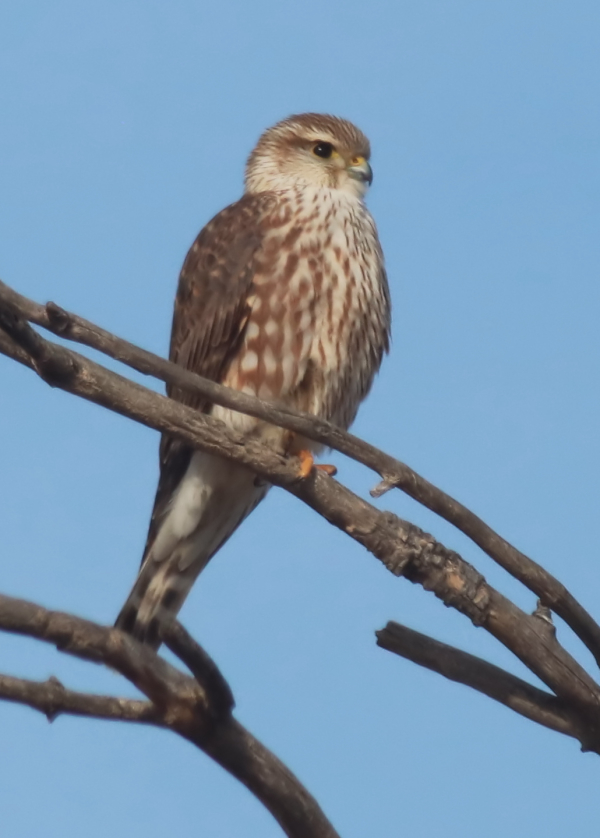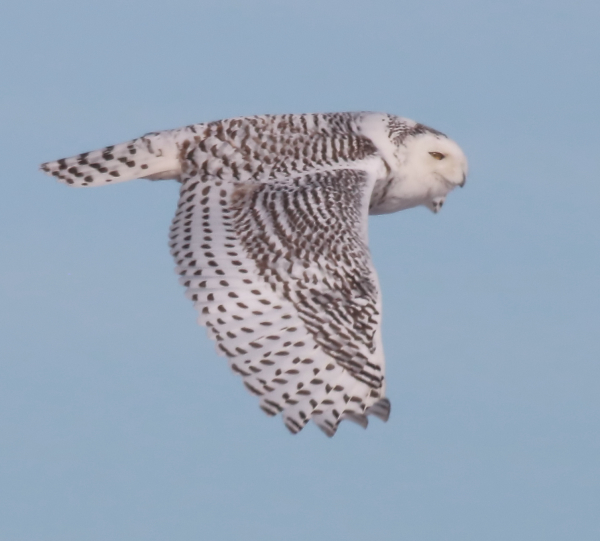
One of the 3 Merlins sighted last Thursday provided outstanding photo opportunities.

A young Snowy Owl was a highlight of the SoDak day trip.

A low-circling Golden Eagle provided some interesting views and photographs of a most-impressive raptor. At times the eagle circled so close that its expansive wings didn’t fit into the photo frame, but provided closer views nonetheless.
|
Hoooray! I was totally surprised late Wednesday night when I checked a revised weather forecast for Pierre and literally jumped out of my chair – an almost windless, sunny day was predicted for Thursday – all day! I usually have more prep time for a monumental day trip, but frankly, all I needed was a few hours of sleep, and I was excited to be on the road at sunrise headed south. The thrills began about 2 hours down the road, and didn’t end until sunset – what fun! How many days do you find 65 diurnal raptors, including 23 eagles, 37 hawks, and 5 falcons – plus one super-exciting nocturnal raptor – a trusting and especially beautiful Snowy Owl.
Centered in the capitol city of Pierre, my SoDak winter raptor hotspot is actually more of a transect, especially now when I limit myself to day trips due to covid precautions. It’s a 280-mile birding drive – one way – more like 590 miles round-trip. But it yields amazing birds during a period when very few birds exist in my neighborhood a couple hundred miles northeast of Pierre. Plus these birding drives provide a remarkable energy surge and attitude adjustment fueled by memorable interactions with remarkable raptors. And the area has consistently yielded better photo opportunities with birds of prey than I have managed anywhere else.
Thursday was raptor-filled with plenty of surprises among the 13 Golden Eagles, 10 Bald Eagles, 15 Rough-legged Hawks, 17 Red-tailed Hawks, a big first-year Ferruginous Hawk, 4 Northern Harriers (2 males and 2 immatures), and falcons! – a male Prairie Falcon, 3 Merlins (no males, 1 Prairie race), and the last raptor of the day, a male American Kestrel hunting from the picturesque top of a big bent-over sunflower head – 65 raptors in all. You can learn more about my interactions with some of these spectacular birds and see the best photos of the day in the Bird Photography article at the end of this issue of The Birding Wire. (I include 3 photos here too.)
Overall, I’m not sure I’ve ever seen as many as 3 Merlins in SoDak, and 1 Merlin provided a fruitful photo session with a little repositioning on my part (see Bird Photography). One of my first morning stops was to investigate an apparent eagle roost. I’ve seen Bald and Golden Eagles in this particular cottonwood grove before, but this time I was surprised to see a Golden Eagle perched only a dozen feet away from a Bald Eagle – that’s a first. There were also 2 more adult Bald Eagles perched in the small grove, along with a surprise Merlin, a pale female of the Prairie race.
Another nice surprise was a young Ferruginous Hawk, a large female that was perched on a low fencepost during my return on a lonely gravel ranch road that plied the Fort Pierre National Grasslands. A male Prairie Falcon was a nice find, and the total of 4 Northern Harriers was a surprise considering I found no harriers during my last visit south.
Comparing Earlier SoDak Sightings
I always like to compare recent trip counts from SoDak to look for changes in raptor numbers. As described in the January 6th issue, my December 18th transect yielded a total of 60 raptors, including 6 Golden Eagles, 17 Bald Eagles, 18 Rough-legged Hawks, 17 Red-tailed Hawks, and 2 American Kestrels. The biggest difference between the 2 day trip counts was that during the December transect, half the number of Golden Eagles were sighted, but there were 70 percent more Bald Eagles than I found last week. During that December count I also didn’t see any Prairie Falcons, Merlins, Northern Harriers, Ferruginous Hawks, or adult male Rough-legged Hawks. During last Thursday’s trip, only the male Rough-legs were lacking. Nonetheless, there are always changes from month to month and year to year, which makes each trip to SoDak interesting.
Snowy Surprise
Perhaps the biggest surprise was a big beautifully marked Snowy Owl, only 7 months removed from its Arctic tundra nest, raised on lemmings, and searching for meadow voles now – or another prey alternative from the top of one of the highest hills 30 miles south of Pierre. It was my 7th Snowy Owl sighting of the season, but my first in South Dakota in 3 years. The bird was especially trusting and I enjoyed spending a little time near it before a big muffler-less farm truck zoomed by, scaring the regal owl into flight. Luck was with me as the white owl paralleled my position with long deep wingbeats highlighted by the afternoon sun, resulting in some nice photos.
The young owl merely repositioned to a pole a couple hundred yards away to resume its daylight scanning. Throughout the earlier period I spent time in company with the Snowy, a flock of about a dozen Horned Larks ‘buzzed’ the owl repeatedly. Although the larks didn’t fly too close, they called as they made repeated flybys. The owl was obviously aware, if not concerned, with their unwelcome attention following their flight as they passed by.
The Snowy Owl and Horned Larks weren’t the only non-raptors I sighted along my drive; other birds included a Northern Flicker, an American Robin, a flock of 6 Western Meadowlarks, a flock of 19 Greater Prairie Chickens, but only one of South Dakota’s state bird – a colorful male Ring-necked Pheasant at the end of the day. A few years ago when I first explored this winter raptor area, I would see more than 100 pheasants in the open in several key habitats, but there was several feet of snow during those winters, which concentrated pheasants. Now, there is almost no snow, so birds are more spread out – including the raptors.
At open water areas along the Missouri River in the Pierre area it was great fun to see flocks of Common Mergansers numbering 7 and 12, along with a couple lone female Hooded Mergansers and 2 drake Common Goldeneyes. As always, there were scattered Mallards and loads of Canada Geese in the area with a few Cackling Geese mixed in. Ring-billed Gulls were also present, and recent observers reported 2 Mew Gulls.
Local Birds
Reality kicked in after my return home from the south: A local drive Saturday turned up no birds. An extended drive Monday had similar consequences until, as I completed a 53-mile circle, I sighted a male Ring-necked Pheasant within a half-mile of my office. I guess the moral of the story is to head south for birding – and that’s an exciting option any day the sun shines in central South Dakota during February.
My feeding station has attracted the same core of birds throughout the winter – Blue Jays, White-breasted and Red-breasted Nuthatches, House Finches, occasional Hairy Woodpeckers, rarely a Downy Woodpecker, and rarer yet, Pine Siskins. Monday a couple Pine Siskins were evident, with the first one showing uncharacteristically intense aggression toward any other birds that approached the platform feeder, raising its wings and chasing other birds away (although no jays or woodpeckers appeared during this bird’s visit).
I hope you had at least one exciting birding activity last week, with more in store for the coming week. Some areas of the country are getting extended snowstorms and colder temperatures that may renew birding thrills at feeders, in the neighborhood, and in the field. Then too, early nesting species such as Bald Eagles and Great Horned Owls are beginning their nesting activities in many areas, while in the Southwest birds like Anna’s Hummingbirds and Mourning Doves have been nesting for some time already – some beginning way back in December. It’s all a matter of where you’re at and what birds surround you, so wherever you reside, keep alert to changes in your area and enjoy the promise of things to come.
Article and photos by Paul Konrad
Share your bird sightings and photos at editorstbw2@gmail.com